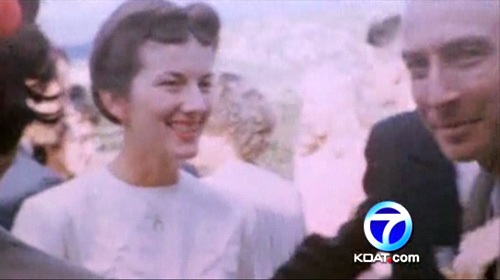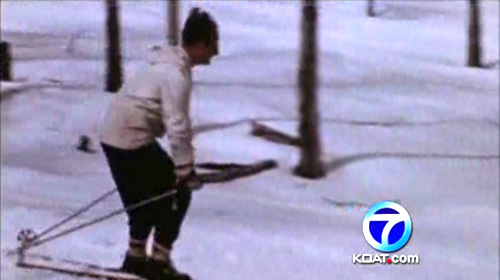One of the things I’ve always found interesting is the emphasis on the social activity that took place at Los Alamos during the Manhattan Project. Parties, lab alcohol, skiing… why is this such a key component in the story of the bomb?
This came up again recently because some new footage has been found of various Los Alamos folk romping around during World War II. It’s kind of amusing, I suppose. We have Hans Bethe on skis, Robert Serber riding a horse, and “OPEN-heimer” aka “OPE-ie” drinking a “martini” (quite clearly champagne).

Longtime Manhattan Project buffs are of course not really surprised by this. Jon Else already covered this ground pretty well in The Day After Trinity, and any Oppenheimer biography goes into great detail about what a great host he was supposed to be and how cold his martinis were (he gets a lot of credit, I might point out, for just using adequate amounts of ice).
But why? The news director and the LANL reps they quote seem to imply that this “humanizes” the bomb scientists. I wonder how much that gets us, intellectually and rhetorically.

Who are we “humanizing” them to, and what are we “humanizing” them against? Is the fear that people will think they are mad scientists of some sort, or people totally disconnected from regular human life, or disconnected from the consequences of their work?
Does seeing them on horses, skis, or at parties change that?
If it does, it suggests a greater failure in understanding human behavior: it suggests that people believe that the creators of weapons, or other “deadly” activities, are somehow less “human” than the rest of us. But we know that even people who do the most inhuman things have days off, have tender moments, and love their children and/or pets. True sociopaths in positions of power are probably the outliers, not the norm.
In Jon Else’s film, there’s an emotional moment when Robert R. Wilson looks guilty about the fact that they had fun making the first nuclear weapons, and that the implications of all of that didn’t sink in until after the bombing of Hiroshima. I don’t know how much I trust recollections like this — a scientist interviewed about nuclear weapons in the 1980s is probably going to think about things pretty differently than he did in, say, 1945 — but it’s an interesting quandary.

Personally, though, I think when thinking seriously about the present and the past, we have to recognize that all human actors are going to be just as complex psychologically as we ourselves are. That means we shouldn’t be surprised that people who do ethically vague (or ethically awful, for that matter) things may be “good people” in other domains of their life, or that they may have good intentions, or that they may compartmentalize their life up in complicated ways.
For me the most depressing part about nuclear weapons has always been that there are perfectly good reasons to make and have them — they aren’t restricted to the domain of “evil” or “crazy” motivations. The trick for those who are opposed to nuclear weapons is to find and create compelling reasons for getting rid of or not acquiring them — and there have been increasingly good arguments on that side as well, over time. For me, “humanizing” the weapons scientist is not about justifying the Manhattan Project, but a key example of what human beings are capable of doing to one another.
But back to those Los Alamos parties for one quick anecdote. When the scientists who had kids wanted to go to a party to whoop it up, they had to get a baby-sitter, right? And who was the baby-sitter? A quite, mild-mannered member of the British delegation who didn’t mind skipping out on social events… named Klaus Fuchs. This caused no shortage of shock in 1950 when it was revealed that he had been a spy the whole time. They not only trusted him with the “secrets” of the bomb, they trusted him with their children. But hey, at least he didn’t give any of them to the Soviet Union…
Some news: NUKEMAP has officially gone “viral.” Following stories in the Daily Mail, the UK Sun, the Toronto Sun, NPR’s Robert Krulwich’s blog, and quite a few other sites, there have been (as of this counting) over 100,000 unique users of NUKEMAP and over 550K “detonations.” I’m still crunching the data and making sense of it all, and I’ll post a full analysis of it on here in a week or so.


A supremely interesting site you have here. Very, very detailed and full of fascinating images I’ve never seen before. Great.
What do you think is going on at 1:20? My vote is for source preparation for a RALA experiment.
Hi, Blake, thanks for writing. I think you’re right about it being RaLa. See this photo from Los Alamos of RaLa preparation that seems to be practically the same setup. (Larger version here; here it is identified as a Ba-140 source used in the experiments.)
Very interesting read. Thanks, Alex.
Bruce
[…] more to say on why it is necessary to humanize weapons creators (see here), or how Americans would feel seeing German or Soviet scientists doing this same thing, but […]
[…] noted a few weeks ago that some new Los Alamos footage had been released. LANL has put up a much longer clip on YouTube. […]